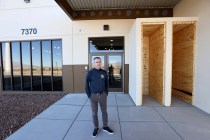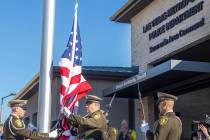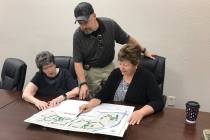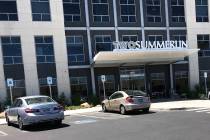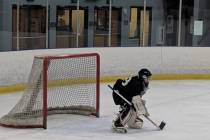Summerlin’s popularity continues to grow despite valley’s dwindling water supply
You hear those snide remarks about Summerlin, about its unique “roundabout” road intersections, about the well-manicured, palm tree-lined streets, the upscale homes in gated communities, the parks, the jogging trails and so much more. Then it all filters into some imaginary or maybe envious reference to those “snooty” or “smug” inhabitants of Summerlin.
But the stark reality is this: The 22,500 acres of land that sit at the edge of Red Rock Canyon National Conservation Area, on the western rim of Las Vegas, form not only the most desirable master-planned community in the Southwest, they represent some of the most sought-after real estate by a growing percentage of home-seekers across America.
Tom Warden, senior vice president of community and government relations for The Howard Hughes Corp., has stated that a fully developed Summerlin will result in housing for 220,000. The present population of Summerlin is about half that number, with some 4,500 acres of undeveloped land still available for residential use. And that includes planned high-rises and other condos for an estimated 4,000 folks destined to live in the 200 acres referred to as phase two of Downtown Summerlin.
However, there’s a real-time problem with all of this, a problem that may be simmering into a conundrum. The cold, hard facts are simply this: Las Vegas continues to grow. Summerlin, irrespective of any real smugness on the part of any of its inhabitants, is in fact one of the most desirable places in the country. But all of that could hit the skids should Mother Nature continue to refuse to cooperate.
While much of the continent is being inundated by a weather pattern that has for some time overflowed rivers, lakes and reservoirs, the American Southwest is suffering through its severest drought on record. And the more new homes we build, whether they’re in Summerlin or anywhere else in Southern Nevada, the more we will require additional amounts of water from a system that may already be too close to the danger zone.
Obviously, property values in Summerlin are high – substantially higher than almost anywhere else in the Las Vegas Valley. And while the most recent U.S. Census Bureau data show continuing annual growth in Las Vegas, it’s a bit odd that the percentage of population increases in Summerlin has not been keeping pace with the rest of the area. But the reason for this anomaly cannot be blamed on a drought that could be building into an imminent crisis, one possibly of monumental proportion.
As you might expect, The Hughes Corp., developer of the master plan for Summerlin, keeps a close watch on home building activity. And according to reports, as the amenities that have made Summerlin so desirable continue to attract hordes of potential home buyers — in turn driving up land values — the actual construction of new homes may be slowing down.
Ironically, that has not been the case in the rest of Las Vegas, as the annual rise in population by almost 10,000 in the most recent census numbers will attest.
Getting back to the drought and the continued dwindling of Lake Mead’s water supply, as well as the shrinking Colorado River that feeds the lake, the fact is that it’s not Summerlin or the alleged smugness of its residents that’s putting a drain on our water supply. It’s the rest of the valley, combined with a mentality that has not yet absorbed the reality of a potential crisis that may be staring us in the face.
Regardless of intensive conservation efforts, the effects of warnings by the Southern Nevada Water Authority, combined with similar energies by the valley’s Water Conservation Coalition — all of which continue to result in saving millions of gallons of water a year — the outlook for all of Southern Nevada may still be bleak. One projection pinpoints dire water shortages by 2017.
Perhaps the best analogy might be a popularized phrase referring to Roman Emperor Nero, who supposedly “fiddled while Rome burned.”
In the case of any impending water crisis, the state’s highest court and some officials may be fiddling around while reservoirs continue to shrink. And all the while folks continue to look for new homes in Las Vegas, especially in Summerlin.
Herb Jaffe was an op-ed columnist and investigative reporter for most of his 39 years at the Star-Ledger of Newark, N.J. His most recent novel, “Double Play,” is now available. Contact him at hjaffe@cox.net.








